Analysis of Regional Differences and Factors Influencing the Intensity of Agricultural Water in China
Abstract
:1. Introduction
2. Methodology and Data
2.1. Study Area
2.2. Index of Regional Differences
2.3. The Spatial Auto-Correlation
2.4. Geographically and Temporally Weighted Regression
2.5. Data Resource and Variables
3. Results and Discussions
3.1. Spatial and Temporal Sequence Analysis of Output Intensity of Agricultural Water
3.2. Spatial Autocorrelation Analysis of Output Intensity of Agricultural Water
3.3. Analysis of Regional Differences of Output Intensity of Agricultural Water
3.4. Temporal and Spatial Analysis of Influencing Factors
4. Conclusions and Policy Implications
Author Contributions
Funding
Institutional Review Board Statement
Informed Consent Statement
Data Availability Statement
Conflicts of Interest
References
- D’Odorico, P.; Chiarelli, D.D.; Rosa, L.; Bini, A.; Zilberman, D.; Rulli, M.C. The global value of water in agriculture. Proc. Natl. Acad. Sci. USA 2020, 117, 21985–21993. [Google Scholar] [CrossRef] [PubMed]
- Sun, S.K.; Yin, Y.L.; Wu, P.T.; Wang, Y.B.; Luan, X.B.; Li, C. Geographical Evolution of Agricultural Production in China and Its Effects on Water Stress, Economy, and the Environment: The Virtual Water Perspective. Water Resour. Res. 2019, 55, 4014–4029. [Google Scholar] [CrossRef]
- Kang, S.; Hao, X.; Du, T.; Tong, L.; Su, X.; Lu, H.; Li, X.; Huo, Z.; Li, S.; Ding, R. Improving agricultural water productivity to ensure food security in China under changing environment: From research to practice. Agric. Water Manag. 2017, 179, 5–17. [Google Scholar] [CrossRef]
- Wang, S.; Hu, Y.; Yuan, R.; Feng, W.; Pan, Y.; Yang, Y. Ensuring water security, food security, and clean water in the North China Plain-conflicting strategies. Curr. Opin. Environ. Sustain. 2019, 40, 63–71. [Google Scholar] [CrossRef]
- Huai, H.; Chen, X.; Huang, J.; Chen, F. Water-Scarcity Footprint Associated with Crop Expansion in Northeast China: A Case Study Based on AquaCrop Modeling. Water 2020, 12, 125. [Google Scholar] [CrossRef] [Green Version]
- Entezari, A.; Wang, R.Z.; Zhao, S.; Mahdinia, E.; Wang, J.Y.; Tu, Y.D.; Huang, D.F. Sustainable agriculture for water-stressed regions by air-water-energy management. Energy 2019, 181, 1121–1128. [Google Scholar] [CrossRef]
- Hoekstra, A.Y.; Mekonnen, M.M. The water footprint of humanity. Proc. Natl. Acad. Sci. USA 2012, 109, 3232–3237. [Google Scholar] [CrossRef] [Green Version]
- Wheeler, T.; Von Braun, J. Climate Change Impacts on Global Food Security. Science 2013, 341, 508–513. [Google Scholar] [CrossRef]
- Brauman, K.A.; Siebert, S.; Foley, J.A. Improvements in crop water productivity increase water sustainability and food security-a global analysis. Environ. Res. Lett. 2013, 8, 024032. [Google Scholar] [CrossRef]
- Li, K.; Liang, S.; Liang, Y.; Feng, C.; Qi, J.; Xu, L.; Yang, Z. Mapping spatial supply chain paths for embodied water flows driven by food demand in China. Sci. Total Environ. 2021, 786, 147480. [Google Scholar] [CrossRef]
- Zhai, Y.; Zhang, T.; Bai, Y.; Ji, C.; Ma, X.; Shen, X.; Hong, J. Energy and water footprints of cereal production in China. Resour. Conserv. Recycl. 2021, 164, 105150. [Google Scholar] [CrossRef]
- Sun, S.K.; Wu, P.T.; Wang, Y.B.; Zhao, X.N. The virtual water content of major grain crops and virtual water flows between regions in China. J. Sci. Food Agric. 2013, 93, 1427–1437. [Google Scholar] [CrossRef] [PubMed]
- Siebert, S.; Kummu, M.; Porkka, M.; Döll, P.; Ramankutty, N.; Scanlon, B.R. A global data set of the extent of irrigated land from 1900 to 2005. Hydrol. Earth Syst. Sci. 2015, 19, 1521–1545. [Google Scholar] [CrossRef] [Green Version]
- Awume, O.; Patrick, R.; Baijius, W. Indigenous Perspectives on Water Security in Saskatchewan, Canada. Water 2020, 12, 810. [Google Scholar] [CrossRef] [Green Version]
- Jin, H.; Huang, S. Are China’s Water Resources for Agriculture Sustainable? Evidence from Hubei Province. Sustainability 2021, 13, 3510. [Google Scholar] [CrossRef]
- Yin, L.; Tao, F.; Chen, Y.; Wang, Y. Reducing agriculture irrigation water consumption through reshaping cropping systems across China. Agric. For. Meteorol. 2022, 312, 108707. [Google Scholar] [CrossRef]
- Wei, J.; Lei, Y.; Yao, H.; Ge, J.; Wu, S.; Liu, L. Estimation and influencing factors of agricultural water efficiency in the Yellow River basin, China. J. Clean. Prod. 2021, 308, 127249. [Google Scholar] [CrossRef]
- Guo, S.; Shen, G.Q.; Peng, Y. Embodied agricultural water use in China from 1997 to 2010. J. Clean. Prod. 2016, 112, 3176–3184. [Google Scholar] [CrossRef] [Green Version]
- Zhang, H.; Zhou, Q.; Zhang, C. Evaluation of agricultural water-saving effects in the context of water rights trading: An empirical study from China’s water rights pilots. J. Clean. Prod. 2021, 313, 127725. [Google Scholar] [CrossRef]
- He, Y.; Wang, Y.; Chen, X. Spatial patterns and regional differences of inequality in water resources exploitation in China. J. Clean. Prod. 2019, 227, 835–848. [Google Scholar] [CrossRef]
- Jiang, L.; Yu, L.; Xue, B.; Chen, X.; Mi, Z. Who is energy poor? Evidence from the least developed regions in China. Energy Policy 2020, 137, 111122. [Google Scholar] [CrossRef]
- Malakar, K.; Mishra, T.; Patwardhan, A. Inequality in water supply in India: An assessment using the Gini and Theil indices. Environ. Dev. Sustain. 2018, 20, 841–864. [Google Scholar] [CrossRef]
- Pang, J.; Li, H.; Lu, C.; Lu, C.; Chen, X. Regional Differences and Dynamic Evolution of Carbon Emission Intensity of Agriculture Production in China. Int. J. Environ. Res. Public Health 2020, 17, 7541. [Google Scholar] [CrossRef]
- Liu, J.; Li, S.; Ji, Q. Regional differences and driving factors analysis of carbon emission intensity from transport sector in China. Energy 2021, 224, 120178. [Google Scholar] [CrossRef]
- Chen, J.; Xu, C.; Cui, L.; Huang, S.; Song, M. Driving factors of CO2 emissions and inequality characteristics in China: A combined decomposition approach. Energy Econ. 2019, 78, 589–597. [Google Scholar] [CrossRef]
- Xu, C. Determinants of carbon inequality in China from static and dynamic perspectives. J. Clean. Prod. 2020, 277, 123286. [Google Scholar] [CrossRef]
- Zhang, Z.; Han, W.; Chen, X.; Yang, N.; Lu, C.; Wang, Y. The Life-Cycle Environmental Impact of Recycling of Restaurant Food Waste in Lanzhou, China. Appl. Sci. 2019, 9, 3608. [Google Scholar] [CrossRef] [Green Version]
- Ren, J.; Lyu, D.; Chen, X.; Liu, P.; Guan, D.; Su, K.; Zhang, H. Oblique extension of pre-existing structures and its control on oil accumulation in eastern Bohai Sea. Pet. Explor. Dev. 2019, 46, 553–564. [Google Scholar] [CrossRef]
- Zhang, L.; Pang, J.; Chen, X.; Lu, Z. Carbon emissions, energy consumption and economic growth: Evidence from the agricultural sector of China’s main grain-producing areas. Sci. Total Environ. 2019, 665, 1017–1025. [Google Scholar] [CrossRef]
- Wang, H.; Pan, X.; Zhang, S. Spatial autocorrelation, influencing factors and temporal distribution of the construction and demolition waste disposal industry. Waste Manag. 2021, 127, 158–167. [Google Scholar] [CrossRef]
- Huang, B.; Wu, B.; Barry, M. Geographically and temporally weighted regression for modeling spatio-temporal variation in house prices. Int. J. Geogr. Inf. Sci. 2010, 24, 383–401. [Google Scholar] [CrossRef]
- Wu, D. Spatially and temporally varying relationships between ecological footprint and influencing factors in China’s provinces Using Geographically Weighted Regression (GWR). J. Clean. Prod. 2020, 261, 121089. [Google Scholar] [CrossRef]
- Wu, B.; Li, R.; Huang, B. A geographically and temporally weighted autoregressive model with application to housing prices. Int. J. Geogr. Inf. Sci. 2014, 28, 1186–1204. [Google Scholar] [CrossRef]
- Chu, H.J.; Huang, B.; Lin, C.Y. Modeling the spatio-temporal heterogeneity in the PM10-PM2.5 relationship. Atmos. Environ. 2015, 102, 176–182. [Google Scholar] [CrossRef]
- Atkinson, A. On the measurement of inequality. J. Econ. Theory 1970, 2, 244–263. [Google Scholar] [CrossRef]
- Sheng, J.; Han, X.; Zhou, H. Spatially varying patterns of afforestation/reforestation and socio-economic factors in China: A geographically weighted regression approach. J. Clean. Prod. 2017, 153, 362–371. [Google Scholar] [CrossRef]
- Wang, Y.; Chen, W.; Kang, Y.; Li, W.; Guo, F. Spatial correlation of factors affecting CO2 emission at provincial level in China: A geographically weighted regression approach. J. Clean. Prod. 2018, 184, 929–937. [Google Scholar] [CrossRef]
- Sá, A.C.; Pereira, J.; Charlton, M.E.; Mota, B.; Barbosa, P.M.; Stewart Fotheringham, A. The pyrogeography of sub-Saharan Africa: A study of the spatial non-stationarity of fire-environment relationships using GWR. J. Geogr. Syst. 2011, 13, 227–248. [Google Scholar] [CrossRef] [Green Version]
- Mcmillen, D.P. Geographically weighted regression: The analysis of spatially varying relationships. Am. J. Agric. Econ. 2004, 86, 554–556. [Google Scholar] [CrossRef]
- O’Sullivan, D. Geographically weighted regression: The analysis of spatially varying relationships. Geogr. Anal. 2003, 35, 272–275. [Google Scholar] [CrossRef]
- Wang, F.; Yu, C.; Xiong, L.; Chang, Y. How can agricultural water use efficiency be promoted in China? A spatial-temporal analysis. Resour. Conserv. Recycl. 2019, 145, 411–418. [Google Scholar] [CrossRef]
- Feng, G.Z. Impacts of and Solutions to Urbanization on Agricultural Water Resources. Ph.D. Thesis, Colorado State University, Fort Collins, CO, USA, 2000. [Google Scholar]
- Avazdahandeh, S.; Khalilian, S. The effect of urbanization on agricultural water consumption and production: The extended positive mathematical programming approach. Environ. Geochem. Health 2021, 43, 247–258. [Google Scholar] [CrossRef] [PubMed]
- Lu, W.; Sarkar, A.; Hou, M.; Liu, W.; Guo, X.; Zhao, K.; Zhao, M. The Impacts of Urbanization to Improve Agriculture Water Use Efficiency-An Empirical Analysis Based on Spatial Perspective of Panel Data of 30 Provinces of China. Land 2022, 11, 80. [Google Scholar] [CrossRef]
- Li, X.; Zhang, X.; Niu, J.; Tong, L.; Kang, S.; Du, T.; Li, S.; Ding, R. Irrigation water productivity is more influenced by agronomic practice factors than by climatic factors in Hexi Corridor, Northwest China. Sci. Rep. 2016, 6, 37971. [Google Scholar] [CrossRef] [Green Version]
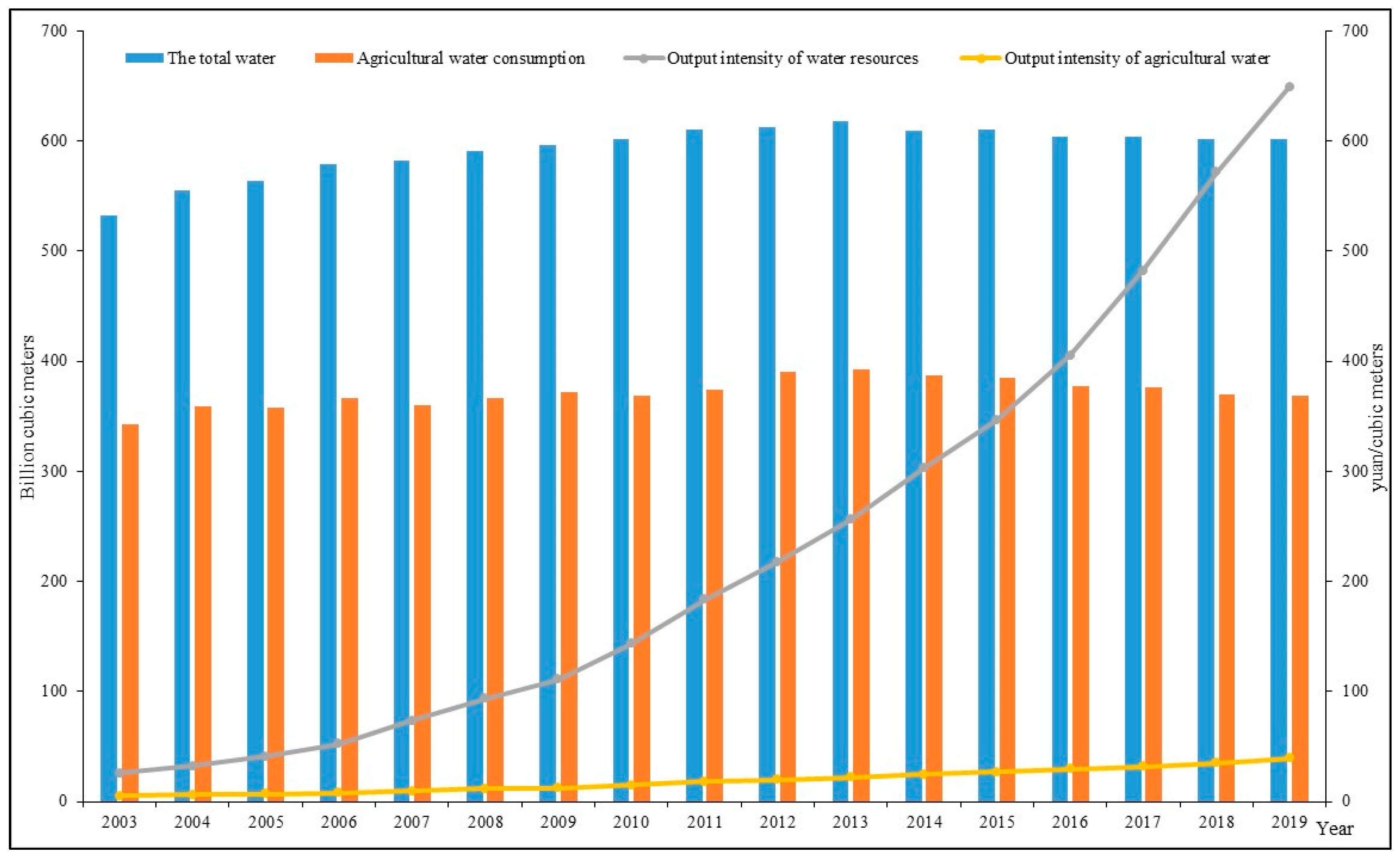
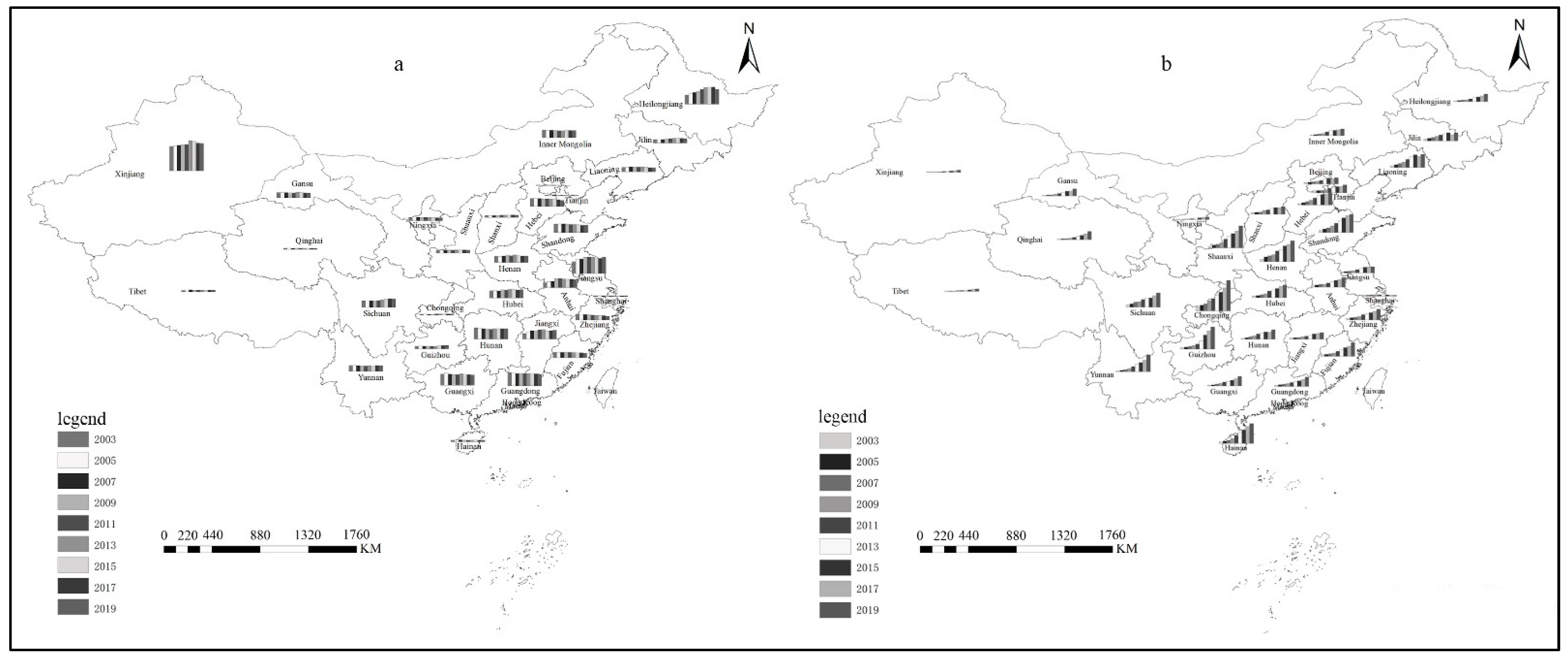
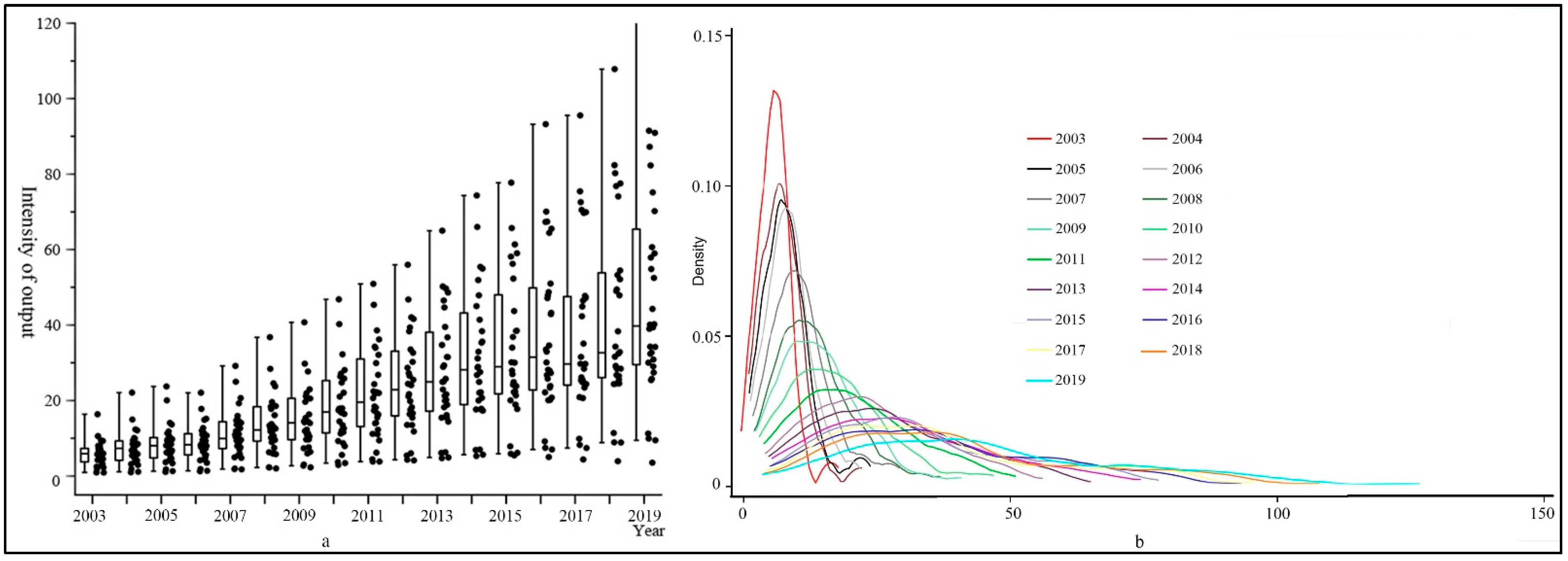
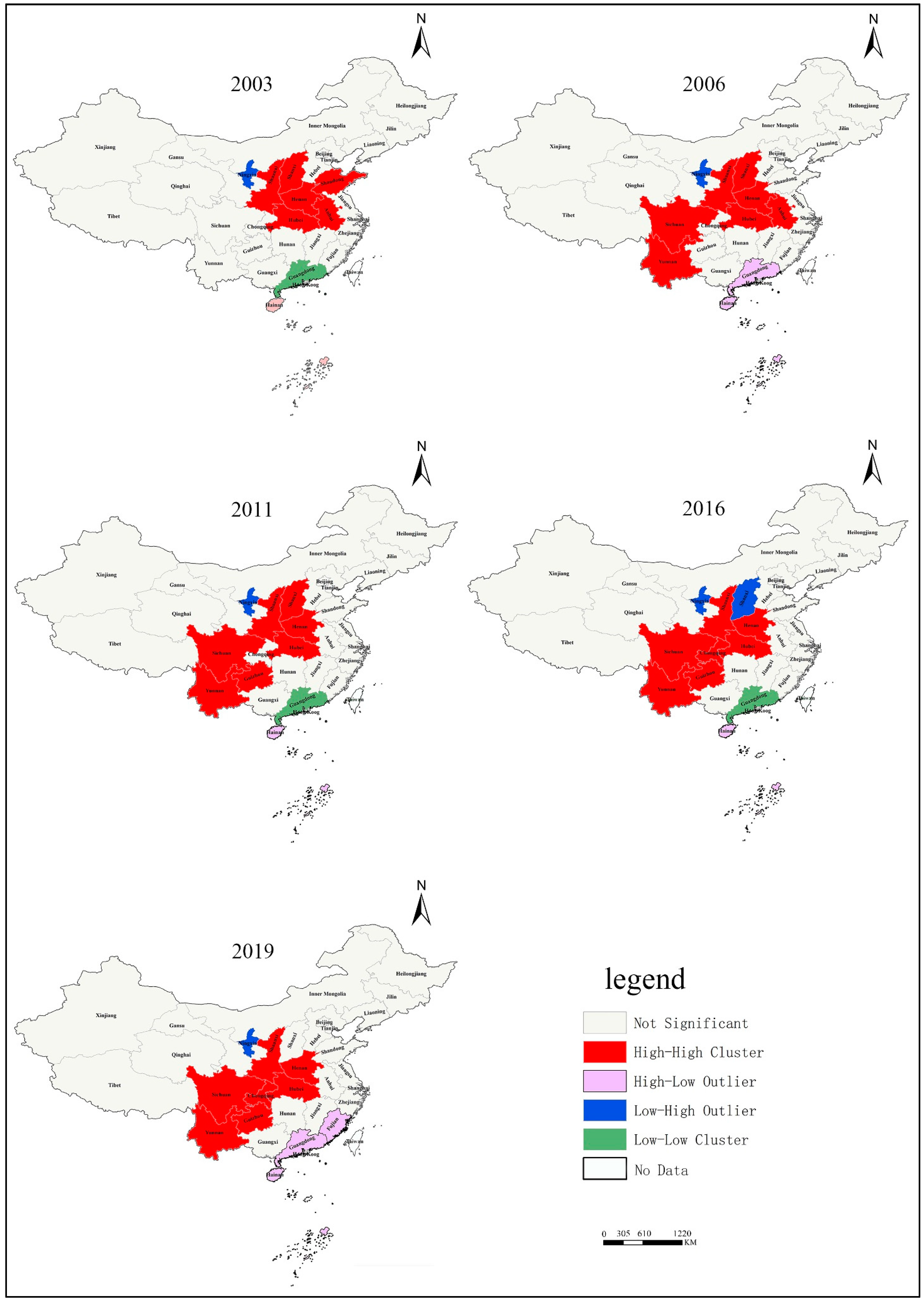


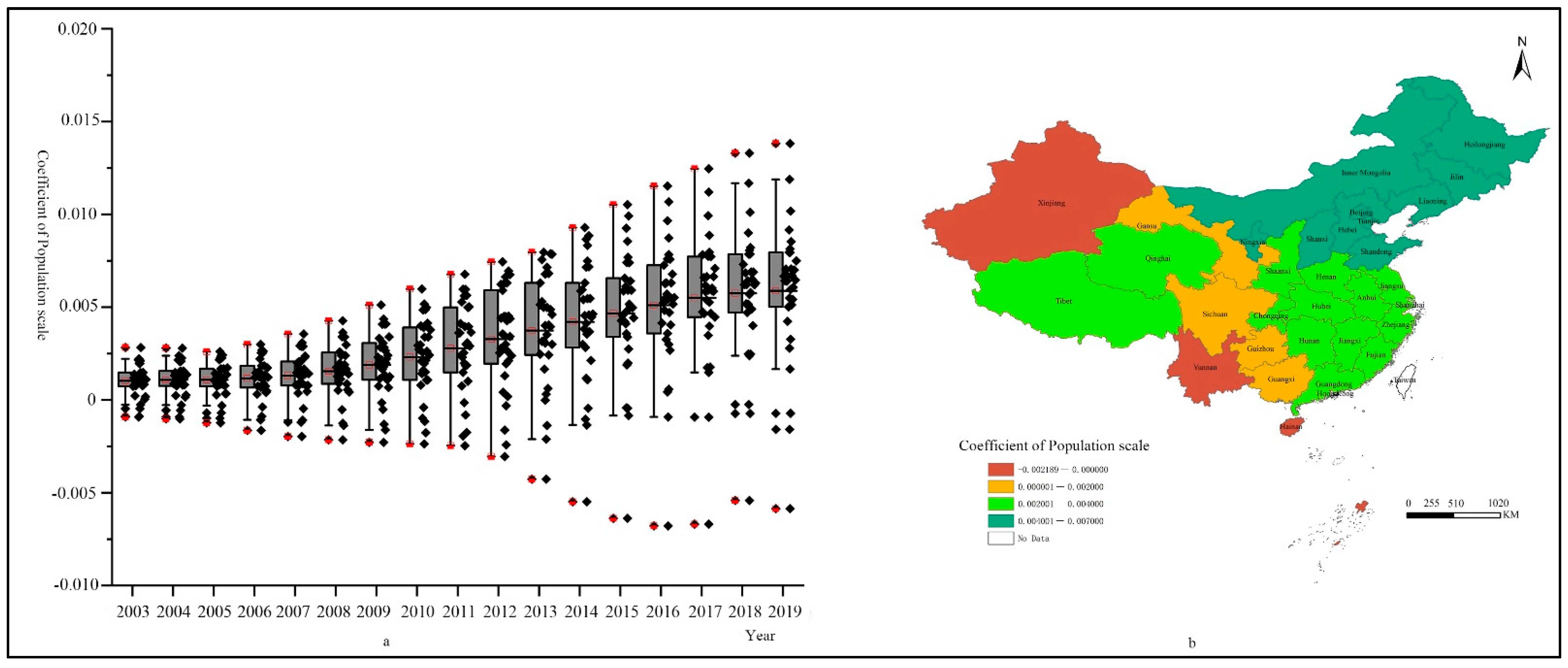
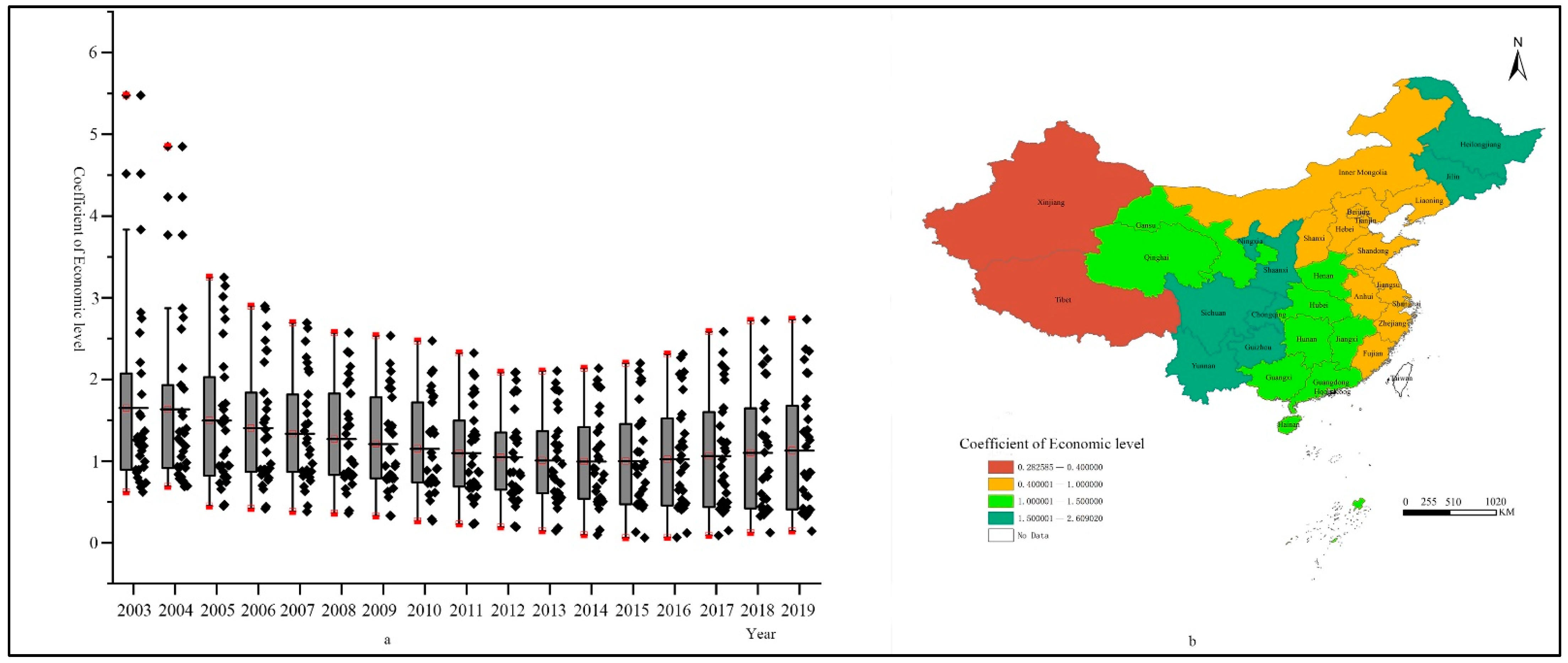
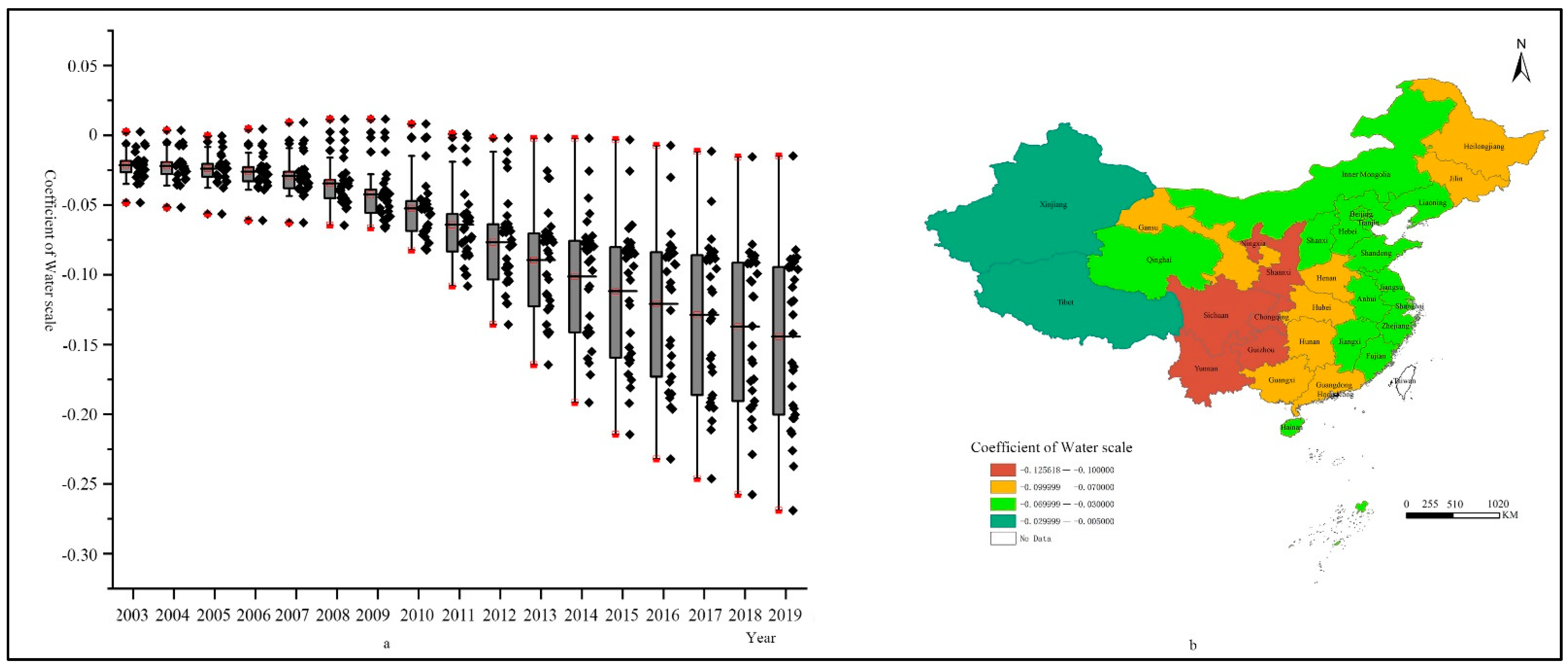

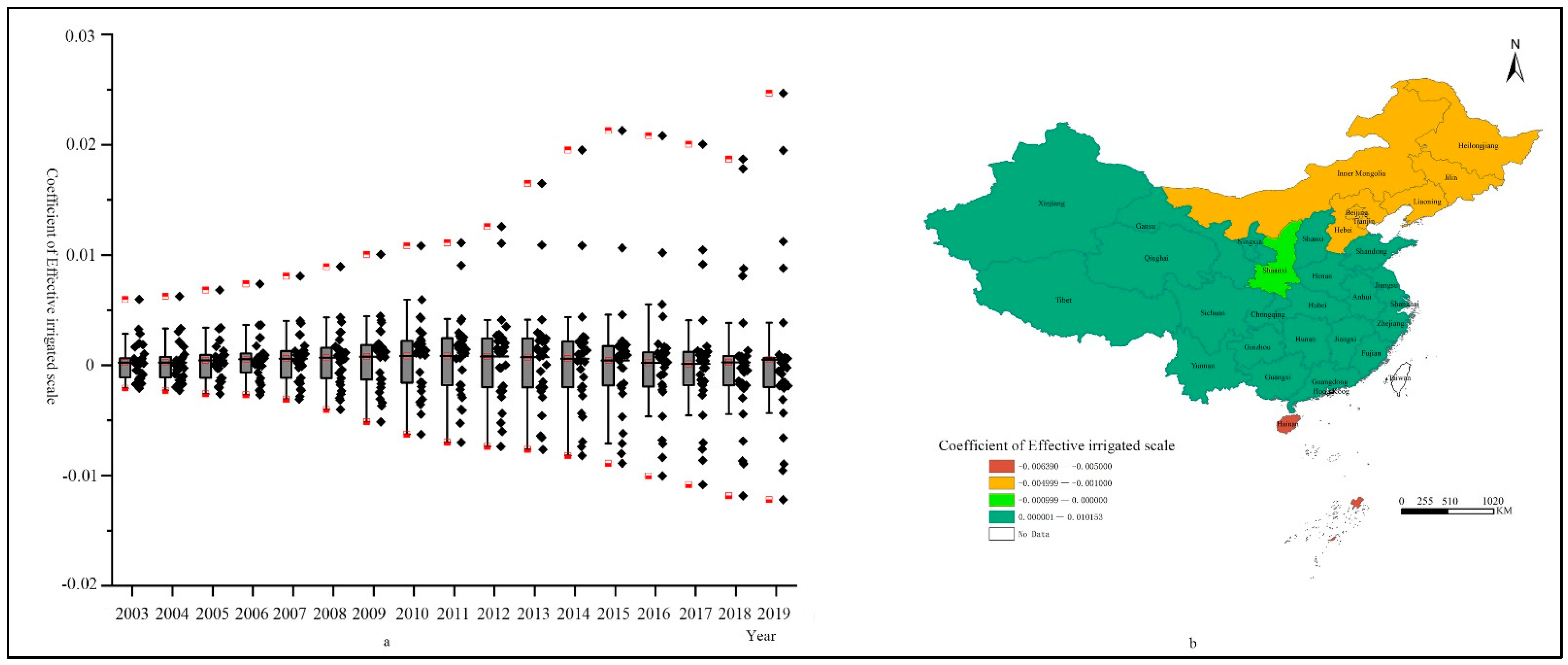
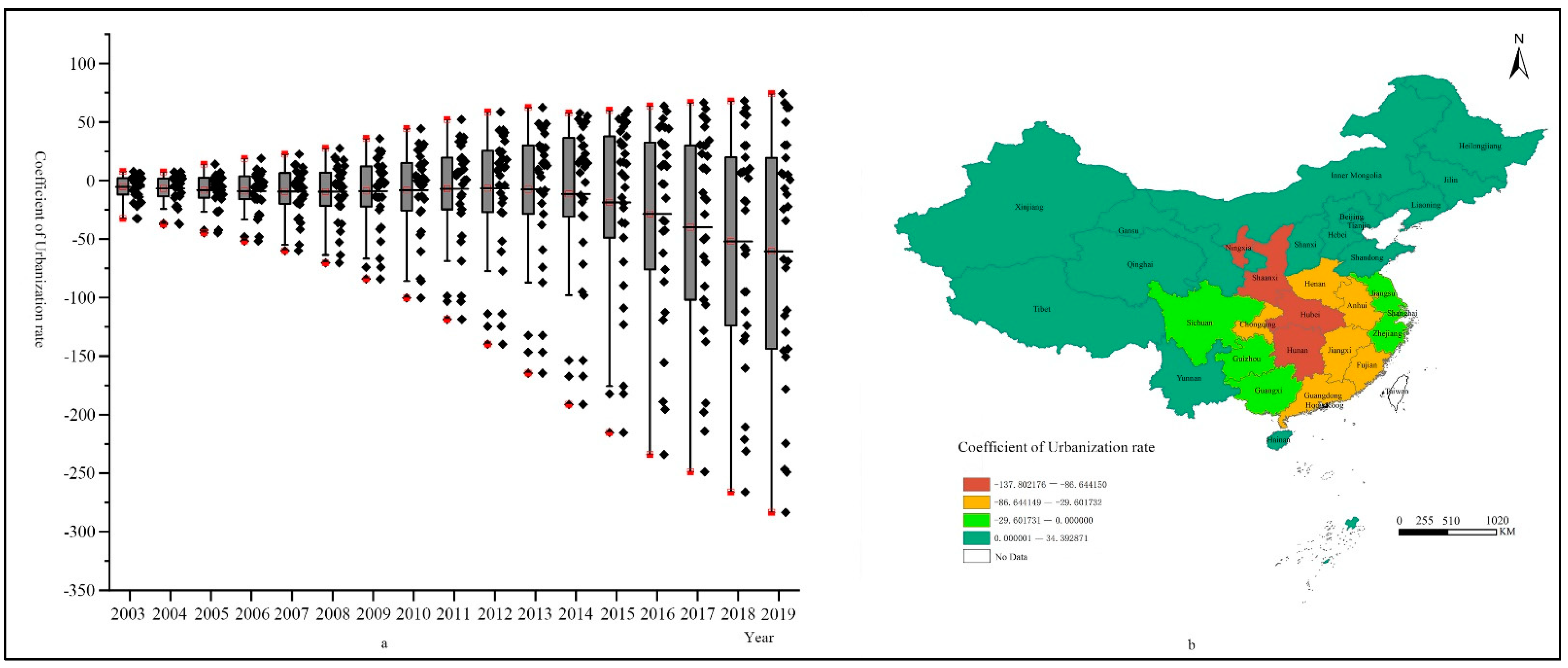
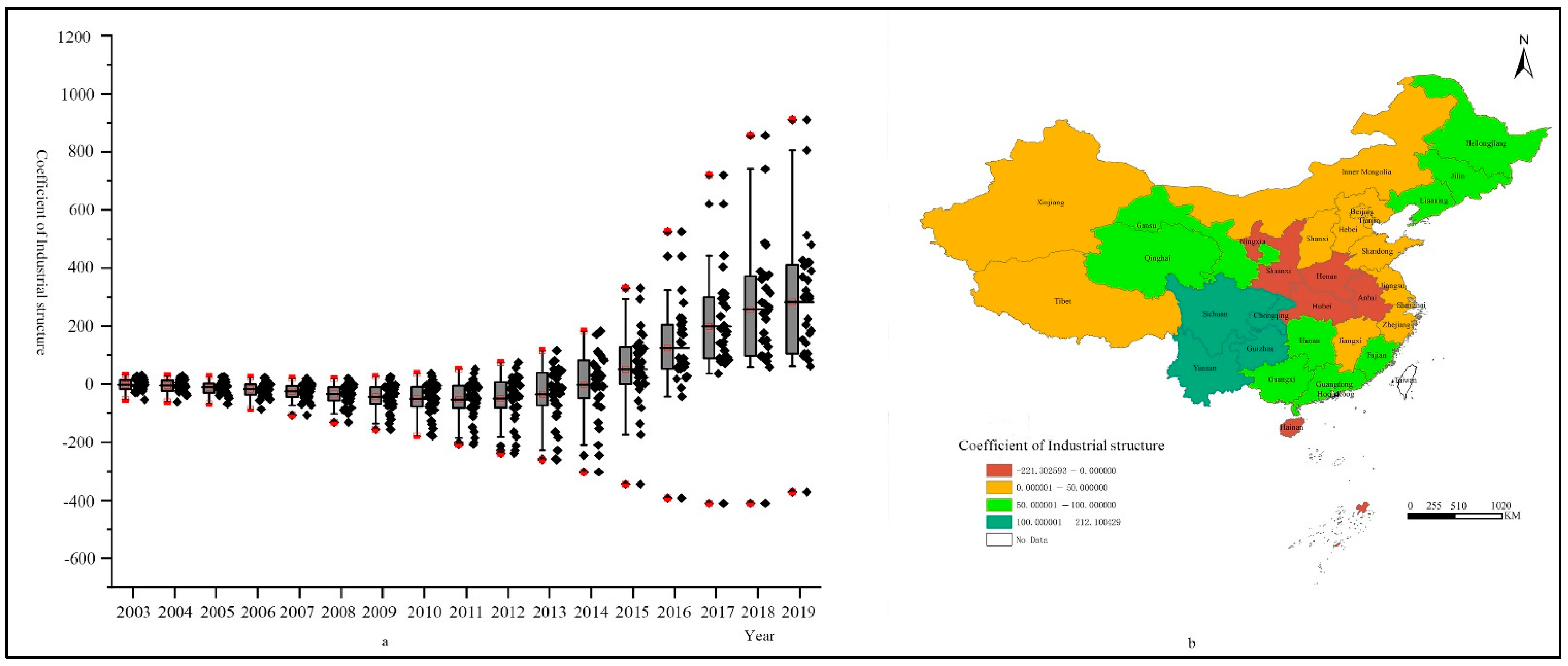
| Variables | Unit | Meaning |
|---|---|---|
| Output intensity of agricultural water | CNY/ton | The ratio of agricultural added value to agricultural water consumption |
| Population scale | 10,000 persons | The total population |
| Economic level | CNY 10,000/person | per capita GDP |
| Water scale | one hundred million tons | Total water use |
| Water use structure | % | The agricultural water accounting for the total water use |
| Effective irrigation scale | thousands of hectares | The area of arable land that can be irrigated normally |
| Urbanization rate | % | The urban population accounting for the total population |
| Industrial structure | % | The added value of agriculture accounting for the proportion of the GDP |
| Year | Moran’I | Z | P | Year | Moran’I | Z | P |
|---|---|---|---|---|---|---|---|
| 2003 | 0.2141 | 3.0809 | 0.0021 | 2012 | 0.1705 | 2.4625 | 0.0138 |
| 2004 | 0.1883 | 2.7782 | 0.0055 | 2013 | 0.1608 | 2.3450 | 0.0190 |
| 2005 | 0.1601 | 2.4022 | 0.0163 | 2014 | 0.1706 | 2.4707 | 0.0135 |
| 2006 | 0.1634 | 2.4031 | 0.0163 | 2015 | 0.1567 | 2.2917 | 0.0219 |
| 2007 | 0.1664 | 2.4511 | 0.0142 | 2016 | 0.1356 | 2.0399 | 0.0414 |
| 2008 | 0.1537 | 2.2958 | 0.0217 | 2017 | 0.1404 | 2.1014 | 0.0356 |
| 2009 | 0.1560 | 2.3289 | 0.0199 | 2018 | 0.1343 | 2.0299 | 0.0424 |
| 2010 | 0.1643 | 2.4166 | 0.0157 | 2019 | 0.1342 | 2.0346 | 0.0419 |
| 2011 | 0.1550 | 2.2765 | 0.0228 |
| Variance Inflation Factor | Tolerance | |
|---|---|---|
| Population scale | 2.99 | 0.335 |
| Economic level | 1.89 | 0.53 |
| Water scale | 1.96 | 0.511 |
| Water use structure | 2.43 | 0.411 |
| Effective irrigated scale | 2.96 | 0.337 |
| Urbanization rate | 2.66 | 0.375 |
| Industrial structure | 2.09 | 0.478 |
| GTWR | GWR | TWR | |||||||
|---|---|---|---|---|---|---|---|---|---|
| Variables | Mean | Max | Min | Mean | Maxi | Mini | Mean | Maxi | Mini |
| INTERCEPT | 15.1800 | 199.4292 | −137.8277 | 3.2647 | 96.6410 | −84.3023 | 35.7858 | 87.0162 | 12.1527 |
| Population scale | 0.0031 | 0.0138 | −0.0068 | 0.0024 | 0.0073 | −0.0073 | 0.0030 | 0.0060 | 0.0007 |
| Economic level | 1.2116 | 5.4779 | 0.0602 | 0.9977 | 2.2001 | 0.1922 | 0.9812 | 1.2584 | 0.4347 |
| Water scale | −0.0721 | 0.0116 | −0.2690 | −0.0653 | 0.0896 | −0.1216 | −0.0694 | −0.0198 | −0.1237 |
| Water use structure | 5.6019 | 197.9471 | −141.5605 | 21.0252 | 103.7339 | −84.0296 | −26.0113 | −12.8423 | −53.0860 |
| Effective irrigated scale | 0.0005 | 0.0247 | −0.0122 | 0.0012 | 0.0131 | −0.0078 | 0.0016 | 0.0025 | 0.0006 |
| Urbanization rate | −17.5160 | 74.1334 | −283.5270 | 4.3439 | 73.5023 | −110.3345 | −39.2333 | −1.5289 | −106.8851 |
| Industrial structure | 34.6773 | 910.4099 | −410.3962 | −91.9469 | 53.3539 | −226.3071 | 169.1647 | 422.9061 | 15.6764 |
| Bandwidth | 0.1150 | 0.1150 | 0.1715 | ||||||
| Residual Squares | 5432.44 | 20,196.50 | 55,339.00 | ||||||
| Sigma | 3.2107 | 6.1906 | 10.2473 | ||||||
| AICc | 2940.74 | 3529.90 | 4010.30 | ||||||
| R2 | 0.9734 | 0.9012 | 0.7294 | ||||||
| Adjusted R2 | 0.9731 | 0.8999 | 0.7257 | ||||||
Publisher’s Note: MDPI stays neutral with regard to jurisdictional claims in published maps and institutional affiliations. |
© 2022 by the authors. Licensee MDPI, Basel, Switzerland. This article is an open access article distributed under the terms and conditions of the Creative Commons Attribution (CC BY) license (https://creativecommons.org/licenses/by/4.0/).
Share and Cite
Pang, J.; Li, X.; Li, X.; Yang, T.; Li, Y.; Chen, X. Analysis of Regional Differences and Factors Influencing the Intensity of Agricultural Water in China. Agriculture 2022, 12, 546. https://doi.org/10.3390/agriculture12040546
Pang J, Li X, Li X, Yang T, Li Y, Chen X. Analysis of Regional Differences and Factors Influencing the Intensity of Agricultural Water in China. Agriculture. 2022; 12(4):546. https://doi.org/10.3390/agriculture12040546
Chicago/Turabian StylePang, Jiaxing, Xue Li, Xiang Li, Ting Yang, Ya Li, and Xingpeng Chen. 2022. "Analysis of Regional Differences and Factors Influencing the Intensity of Agricultural Water in China" Agriculture 12, no. 4: 546. https://doi.org/10.3390/agriculture12040546
APA StylePang, J., Li, X., Li, X., Yang, T., Li, Y., & Chen, X. (2022). Analysis of Regional Differences and Factors Influencing the Intensity of Agricultural Water in China. Agriculture, 12(4), 546. https://doi.org/10.3390/agriculture12040546






